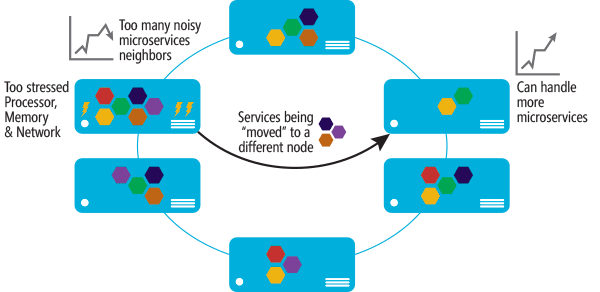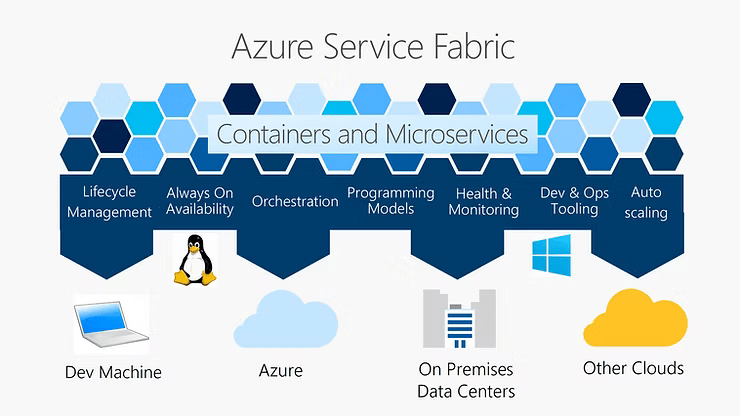
- Introduction to Azure Service Fabric
- Core Concepts and Architecture
- Deploying Applications on Azure Service Fabric
- Key Features and Capabilities
- Comparison with Kubernetes and Other Orchestrators
- Common Use Cases and Scenarios
- Monitoring and Scaling in Service Fabric
- Security and Compliance Considerations
- Conclusion
Introduction to Azure Service Fabric
Azure Service Fabric is a distributed systems platform developed by Microsoft for building, deploying, and managing highly scalable and reliable microservices-based applications. It simplifies the complexity of creating applications that are highly available and scalable while enabling flexibility in managing these applications across various infrastructure types, from on-premises servers to cloud environments such as Microsoft Azure Training. Service Fabric is a platform-as-a-service (PaaS) offering that allows developers to focus on their application logic while it handles the underlying infrastructure concerns, such as provisioning, health management, failure recovery, scaling, and load balancing. It was initially created to support large-scale applications like Azure SQL Database and Skype but has since evolved to be used by many other types of applications, from stateful to stateless services. In this comprehensive guide, we will dive into Azure Service Fabric’s core concepts and architecture, its key features, a comparison with Kubernetes and other orchestrators, deployment strategies, use cases, monitoring, scaling, and security considerations.
Core Concepts and Architecture
Azure Service Fabric is built around a distributed systems architecture that makes it a versatile and resilient platform for managing microservices-based applications. Here are some of its key architectural concepts:
- Clusters A Service Fabric cluster is the fundamental building block of Service Fabric. It is a group of virtual machines (VMs) or physical servers that are networked together to work as a single unit. A cluster hosts and manages the lifecycle of your applications, whether they are running on Azure or on-premises.
- Nodes Each machine in a cluster is referred to as a node. These nodes run the Service Fabric runtime that hosts services and manages the communication between services. A cluster can have multiple types of nodes, including Primary nodes responsible for running primary services. Replica nodes handle replicated service instances for high availability.
- Services Services in Service Fabric are typically broken down into two categories, Stateless Services do not retain any state between requests. They can be scaled horizontally by adding or removing instances. Stateful Services maintain state and provide guarantees about reliability. They are designed to ensure that data remains consistent even in the face of failures. Service Fabric uses replication to ensure high availability for stateful services.
- Partitions and Replicas Stateful services in Service Fabric use the concept of partitions and replicas. Partitions are logical subdivisions of data within a service. Partitions allow the data to be distributed across multiple nodes in the cluster for scalability and fault tolerance. Replicas are copies of a partition’s state that are spread across different nodes to ensure availability and Secure Efficient Azure Storage Management.
- Reliability and Fault Tolerance Service Fabric automatically handles failure recovery by monitoring the health of services and their instances. If a node fails, Service Fabric can recover the affected services by redistributing them across healthy nodes.
- Health Model Service Fabric has a health model that continuously monitors the health of both the services and the cluster. It uses a concept of health checks, where each component (e.g., service, replica, or partition) can report its status (e.g., healthy, warning, or unhealthy). If any component becomes unhealthy, Service Fabric will take steps to rectify the issue.
Master Microsoft Azure skills by enrolling in this Microsoft Azure Training today.
Deploying Applications on Azure Service Fabric
Deploying applications on Azure Service Fabric can be done through various approaches, such as using Visual Studio, the Azure Portal, or PowerShell/Azure CLI. The process begins with creating a Service Fabric cluster, which can be done via the Azure Portal or Azure CLI. During this step, you will select the number of nodes, choose the operating system, and define the configuration settings, such as availability zones. After the cluster is set up, you can develop microservices using tools like Visual Studio or Azure DevOps. Boost Performance With Azure Expressroute services are then packaged into application packages, whether stateful or stateless, and prepared for deployment. Once the application is ready, it can be deployed to the cluster using PowerShell commands or Azure CLI, specifying service types, replicas, and health policies. After deployment, you can monitor the application’s health using Azure Service Fabric Explorer, which provides real-time insights into services, nodes, and partitions. Additionally, scaling policies can be defined for both stateless and stateful services, adjusting based on resource utilization to ensure optimal performance.
Ready to excel in Microsoft Azure? Enroll in ACTE’s Microsoft Azure Training and begin your journey today!
Key Features and Capabilities
Azure Service Fabric offers several powerful features and capabilities that set it apart from other orchestrators and platforms. Below are some of the most notable features:
- Microservices Architecture Service Fabric is designed around a microservices architecture, enabling developers to break down complex applications into small, independently deployable services. Azure Hdinsight Big Data in the Cloud architecture provides flexibility, scalability, and fault tolerance, as each service can be updated, scaled, and managed independently.
- Stateful and Stateless Services Unlike other orchestration platforms, which focus mainly on stateless services, Service Fabric allows developers to build stateful microservices with built-in data persistence. This capability is essential for applications that require reliability and consistency, such as financial applications, e-commerce systems, or IoT platforms.
- Automatic Scaling Service Fabric allows you to automatically scale your services based on demand. You can define policies that scale services vertically (adding more resources to existing instances) or horizontally (adding more instances to meet the demand). This automatic scaling helps ensure that the application performs well under varying workloads.
- Integrated Health Monitoring Service Fabric provides built-in health monitoring and failure detection. It automatically detects failures in services, replicas, and infrastructure, and can take remedial actions, such as restarting services or redistributing replicas to healthy nodes.
- Rolling Upgrades and Zero-Downtime Deployment Service Fabric supports rolling upgrades, which allows you to update services and applications without downtime. Microsoft Azure Training ensures that only a portion of the services are upgraded at a time, and it monitors the health of the updated services before continuing with further upgrades. This feature is critical for enterprises that require high availability.
- Multi-Cloud and Hybrid Deployments While Azure Service Fabric is tightly integrated with Azure, it also supports on-premises and multi-cloud deployments. You can use Service Fabric to manage services across a hybrid infrastructure, providing a unified management platform for both on-premises and cloud applications.
- Multi-Language Support Service Fabric supports a wide range of programming languages, including .NET, Java, Node.js, and Python. This multi-language support ensures that developers can use the tools and technologies they are comfortable with while benefiting from the powerful orchestration capabilities of Service Fabric.
- Orchestration Approach: Kubernetes is primarily designed to manage stateless containers and applications that can scale horizontally. Azure Service Fabric, on the other hand, natively supports both stateless and stateful services, which makes it more suitable for applications that require guaranteed consistency, such as databases, queues, and caching systems.
- Complexity: Kubernetes can be more complex to set up and configure, especially for stateful applications, while Service Fabric has built-in support for stateful services without requiring complex configurations.
- Service Management: Kubernetes requires the user to manage the state of services externally (through Persistent Volumes or external storage solutions). Service Fabric provides built-in state management for both stateless and stateful services.
- Platform Support: Kubernetes can run on various cloud platforms, such as Azure Services and Products to Explore, Google Cloud, and Azure, and is highly flexible. Azure Service Fabric is optimized for Azure but also supports hybrid and on-premises deployments.
- Monitoring Service Fabric provides a set of monitoring tools, including Azure Service Fabric Explorer a web-based tool that provides real-time status of the Understanding Azure Load Balancer. Azure Monitor Integrates with Service Fabric to provide centralized monitoring and alerting.
- Scaling Service Fabric can automatically scale services based on defined metrics, such as CPU usage or memory consumption. You can configure horizontal scaling (adding more instances) and vertical scaling (adjusting resource allocation for existing instances).
- Identity and Access Management Service Fabric integrates with Azure Active Directory (AAD) to provide role-based access control (RBAC) for managing access to resources in a cluster.
- Data Encryption Service Fabric supports data encryption both at rest (on disk) and in transit (via SSL/TLS) to ensure the confidentiality and integrity of data.
- Compliance Service Fabric meets several industry standards for compliance, such as GDPR, ISO, and SOC, making it suitable for highly regulated industries like finance and healthcare.

Comparison with Kubernetes and Other Orchestrators
Azure Service Fabric is often compared with Kubernetes, one of the most popular container orchestration platforms. Both platforms manage microservices and containers, but there are significant differences:
While Kubernetes is excellent for containerized workloads and microservices, Service Fabric is better suited for enterprise-grade applications that require stateful management, guaranteed reliability, and multi-platform deployments.
Want to lead in Cloud Computing? Enroll in ACTE’s Cloud Computing Master Program Training Course and start your journey today!
Common Use Cases and Scenarios
Azure Service Fabric is ideal for a variety of applications that demand high availability, fault tolerance, and scalability. It excels in managing microservices-based architectures, where each service performs a specific task and can be scaled, upgraded, or replaced independently. Automate Security with Azure Sentinel is also well-suited for Internet of Things (IoT) applications, where large volumes of data from devices need to be processed by low-latency, high-availability services. For applications requiring consistent data storage, such as e-commerce platforms and financial applications, Service Fabric offers stateful services that ensure data consistency and durability. Additionally, Service Fabric is capable of managing applications deployed across both on-premises and cloud environments, making it an excellent choice for hybrid and multi-cloud deployments.

Monitoring and Scaling in Service Fabric
Monitoring and scaling are key capabilities of Azure Service Fabric that help maintain performance and reliability.
Preparing for a job interview? Explore our blog on Microsoft Azure Interview Questions and Answers!
Security and Compliance Considerations
Azure Service Fabric provides robust security features to protect your applications and data. Key security capabilities include:
Conclusion
Azure Service Fabric is a powerful platform for building, deploying, and managing distributed, microservices-based applications. It provides deep integration with Microsoft Azure Training , robust support for both stateful and stateless services, and comprehensive monitoring, scaling, and security capabilities. Whether you’re building an enterprise-grade application or scaling a cloud-native service, Service Fabric offers the tools and flexibility needed to support complex workloads with high availability and fault tolerance. By comparing Service Fabric with other orchestrators like Kubernetes, we see that it provides unique features tailored to the demands of enterprise-level, stateful applications.





